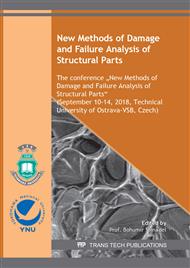p.27
p.34
p.40
p.46
p.52
p.58
p.64
p.70
p.76
Corrosion Properties of ECAP Titanium with Bioactive Oxide Coating in Physiological Solution
Abstract:
This paper aims to comparison of corrosion properties of two titanium alloys with different grain size. These alloys are commonly used in implantology for manufacturing long term body hard tissues replacements. Surfaces of tested samples were also electrochemically anodized using fluorine ions rich environment: the main reason for anodization was to create surfaces with highly bioactive properties which can intensify healing process and result into better bonding between body tissues when they are used in implantology. It was found by direct electrochemical methods that difference of corrosion rate between anodized and non-anodized samples was not significant. Anodization results positively influenced decreasing of corrosion rate when samples were tested in aerated physiological solution (0,9 wt. % NaCl/water). Type of bonding between implant and surrounding tissue may be also predetermined by value of contact angle of tested sample and water droplet on its surface. This paper confirmed that anodization increases wettability of tested samples and lower the contact angle to ~60°. According to these results anodization process may be recommended as a profitable treatment for surfaces of tissue replacements made from titanium.
Info:
Periodical:
Pages:
52-57
Citation:
Online since:
July 2019
Authors:
Keywords:
Price:
Сopyright:
© 2019 Trans Tech Publications Ltd. All Rights Reserved
Share:
Citation:



